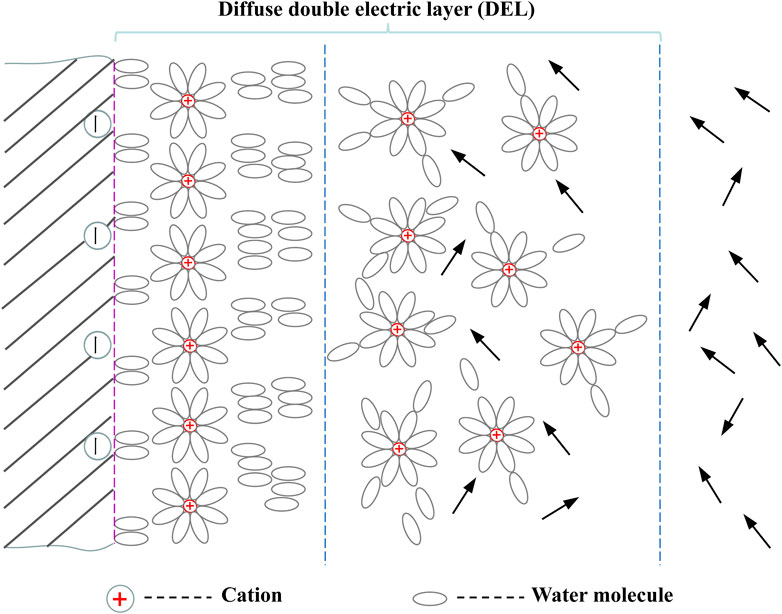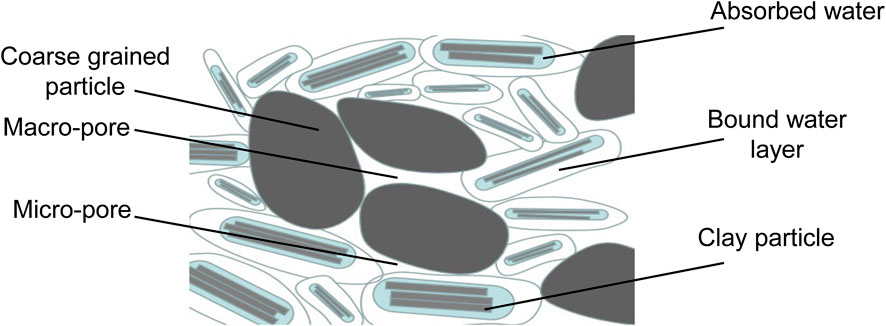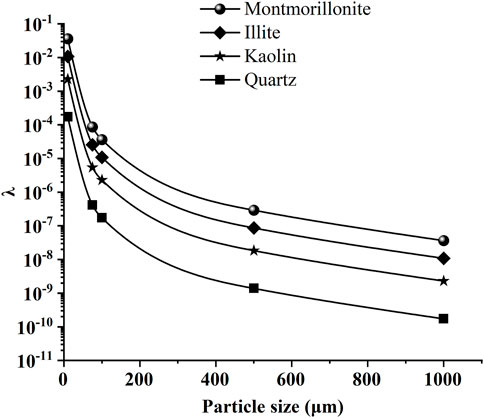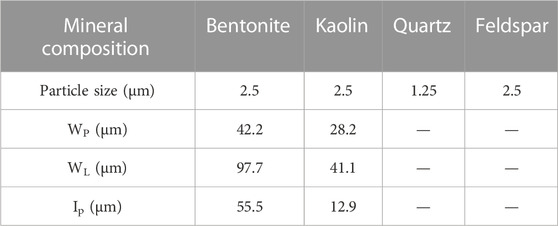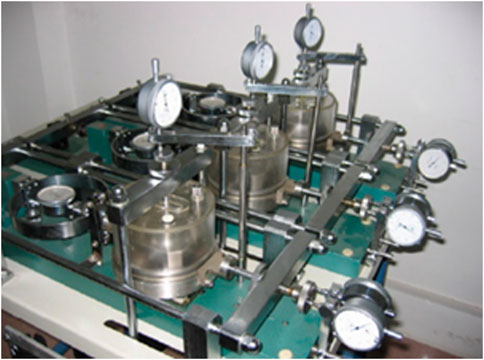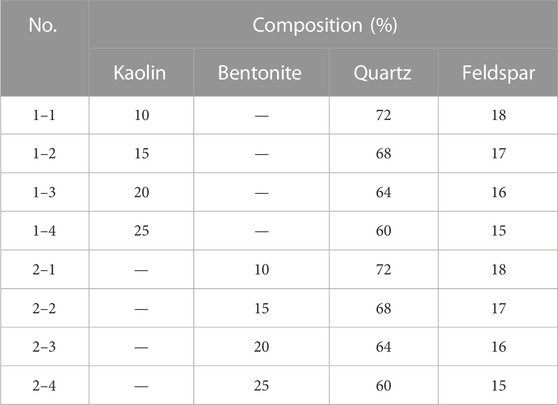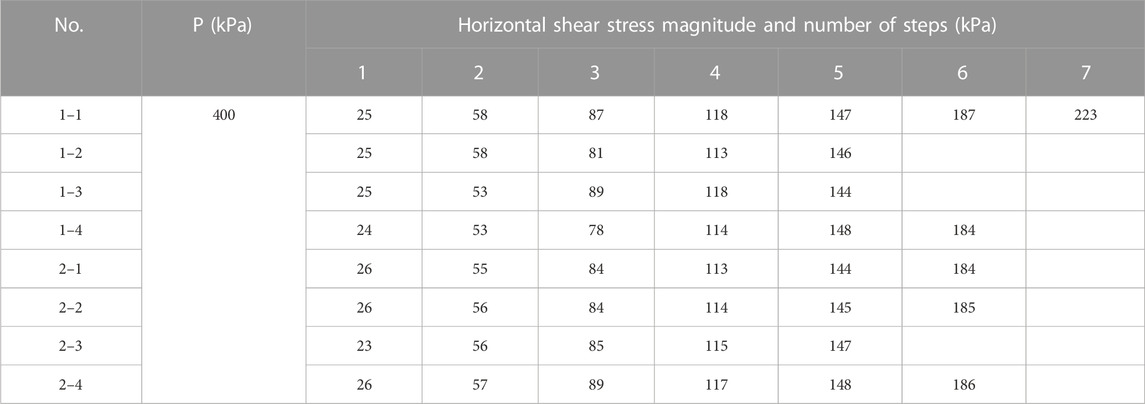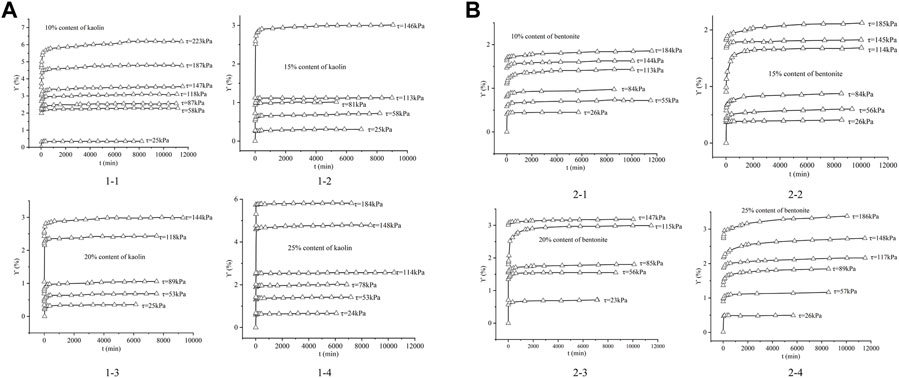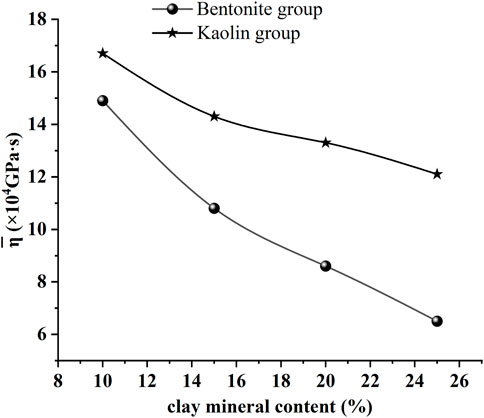- Guangzhou University, Guangzhou, Guangdong Province, China
The study of the creep properties of soils is of great importance for the management of future settlements and the safe use of buildings. However, starting from the micro level is an effective way to explore the creep mechanism of soft soil. In this paper, the influence of the mineral composition and the mineral content on the structure and creep properties of soft soil was analyzed at the microscopic level and the energy scale method was proposed. Then, the energy scale method was used to analyze and discuss the results of the direct shear creep test. The discussion showed that 1) the average viscosity coefficient of kaolin was greater than that of bentonite, which decreased with an increase of kaolin and bentonite; 2) the thickness of adsorbed water or the double electric layer (DEL) on the particle surface was positively correlated with the soft soil creep; and 3) λ was positively correlated with the adsorbed water content and negatively correlated with the average viscosity coefficient of the soft soil. λ characterized the adsorption capacity of the particles at the micro level; hence, the energy scale method can explain the mechanism of the soft soil creep at the microscopic level and also quantitatively describe the influencing law of the basic characteristics of the particles on the properties of the soft soil creep.
1 Introduction
Soft soils are widely distributed all over the world and are characterized by a large porosity, high water content, high compressibility, low shear strength, and bearing capacity (Xiang et al., 2021; Naeini and Mohammadi, 2022). Generally, soft soils show an evident creep phenomenon, for example, even though the main consolidation has been completed, soft soil foundations still experience deformation for a long time (Tsugawa et al., 2019). The deformation of soft soil by the creep also leads to an uneven settlement of buildings, and the Leaning Tower of Pisa is an example of this. In order to reduce the engineering hazard caused by the creep of soft soil, scholars have conducted a lot of research on the creep in soft soils.
The process of analyzing the mechanism of the soil creep phenomenon through laboratory tests has always been welcomed by scholars. First, scholars found that test conditions had an impact on the creep behavior of soft soil. For example, Wei et al. (2014) conducted a triaxial consolidation undrained shear creep test and concluded that the increase of pore water pressure makes the creep properties of silt soft soil more significant. Huang et al. (2020) conducted the lateral unloading creep test under a different excess pore water pressure, and the results showed that the higher the excess pore water pressure, the more evident the creep of soft soils. Evidently, the nature of soft soil itself, such as the mineral composition and structural characteristics, has a more fundamental impact on its creep properties (Yuan et al., 2022). Liu et al. (2018) concluded that clay minerals, especially montmorillonite, play an important role in the creep of clay rocks through the triaxial creep test. Ni and Huang (2020) found that the influence of the mineral composition on the creep properties was much more significant than that of the other factors observed through zeta potential analysis of kaolinite, montmorillonite, and illite. Brezzi et al. (2018) used cohesive materials for collapse testing, aiming to assess how the composition of cohesive mixtures affects flow properties. Further research showed that adsorbed water on the surface of particles was an important factor in the creep properties of soft clay soils, for example, there is a correlation between the coefficient of viscosity of soft soils and the thickness of adsorbed water (Zhang and Wang, 2011; Xiao et al., 2014; Yang, 2017). In addition to the external environment, the mineral composition of particles has the most evident effect on the water adsorption state on the surface of particles (Wu, 2015; Bai et al., 2021a). For example, Gu and Fang (2009b) proposed the concept of “creep substances” and experimentally analyzed the relationship between creep properties and creep substances such as organic matter (Gu and Fang, 2009a) and clay minerals. Fang (2014) suggested that creep substances on the surface of soil particles charged them and then adsorbed water molecules to form adsorbed water; so, soil particles were connected by adsorbed water to show the overall creep properties. Tang (2021) performed isothermal adsorption tests on artificial mixed clay, and the results showed that the adsorbed water content of the mixed clay increased linearly with the increase of the montmorillonite content, and the mineral composition of the clay (montmorillonite) was the most basic influencing factor. The aforementioned research studies were mainly about the creep properties of soils from the macro scope, but the variation of the microstructure of particles is the true reflection of macro-mechanical behavior. Therefore, in order to study the intrinsic mechanism of the soft soil creep, the laws of the macroscopic creep properties and microstructural changes in soft soils have received increasing attention (Zhu et al., 2017; Zhu et al., 2019). Micromechanical studies of the soil creep have been carried out as early as the 20th century. For example, based on the rate process theory, Kuhn and Mitchell (1993) derived an expression for the ratio of the creep velocity of two contacting particles to the tangential contact force component and the normal contact force component, and introduced it into the discrete element model (DEM). Numerical simulations show that the variation of the creep velocity is related to the variation of the contact forces in tangential and normal directions. Thereafter, Gao et al. (2023) performed a numerical simulation of the biaxial shear creep in sandy soils using the discrete element method and analyzed the contribution of three contact motion modes, contact deformation (normal and tangential), Type4 rolling, and rigid-body motion, for the deformation of the specimen, where contact deformation mainly contributed to the overall volume change in terms of the overall volume strain. The studies of these scholars have shown that there is a correlation between the micro-level parameters of the soil and the macro-mechanical properties (Bai et al., 2021b), and the DEM method helps in exploring the response law between the micro-contact forms of particles and the macro-mechanical phenomena. However, due to the multi-hybrid nature of the mineral composition in soft soils, the parameter calibration of the DEM method is tedious and complicated, and the DEM method is not used in this paper for the characterization of particle microscopic contact forms.
The method of the experimental test to analyze the mechanism of the creep phenomenon in soft soil can be designed in advance to study the factor and analyze the response law of that factor and creep behavior in a targeted manner. Experimental analyses play a great role in the study of the creep mechanism from the external conditions to soft soil’s factors. However, experimental studies focus on macro-level analyses and cannot truly reflect the intrinsic mechanism of the soft soil creep. For this reason, some scholars have used the discrete element method to characterize the microscopic contact morphology of particles in terms of their tangential and normal forces and then analyze the relationship between the microscopic contact morphology of the particles and creep behavior. However, due to the complexity of the soft soil composition, the calibration of discrete element parameters is often complicated; so, a new idea is adopted in this paper, where the ratio of circumferential and normal forces is directly used to characterize the microscopic contact morphology of particles.
It can be seen that the research results on the mechanism of the soft soil creep are relatively abundant but most of them consider the influence of each factor on the creep properties of soft soil in a single and scattered manner. The mineral composition and content, and binding water are coupled together to influence the macro creep properties of soil. The thickness of the adsorbed water film depends mainly on the soil composition and content, while the creep properties of clay are inseparable from adsorbed water. Therefore, in order to explore the coupling mechanism of multiple factors on soil creep, this paper adopted the energy scale method for the characterization of microscopic contact characteristics of soft soil particles based on the three factors of mineral composition, mineral content, and adsorbed water content. Then, we used the coefficient of viscosity as a parameter to quantify the macroscopic creep characteristics of soft soil. Finally, the quantitative relationship between the microscopic characteristics of particles and macroscopic creep characteristics was established to provide a multifactor coupling mechanism for future research on the soft soil creep. This paper will provide a useful reference for future research on the mechanism of multifactor coupling of the soft soil creep.
2 Energy scale method
Soft soils contain many clay particles; the clay particles always have a small specific surface area (SSA) and larger negative surface charges. The negative charges adsorb polar water molecules and cations to form an ionic liquid layer on the surface of the particles. This ionic liquid layer has a certain viscosity and is known as the diffused double electric layer (DEL, as shown in Figure 1). In the DEL, several water molecules are directly attached to the particle surface and considered immobile. These water molecules have solid shear resistance properties and are referred to as strongly adsorbed water. Compared with the small clay particles, the thickness of the DEL or adsorbed water is really considerable. So, the contact between clay particles in soft soils is more of the contact of the DEL or adsorbed water rather than the particles (as shown in Figure 2). As is commonly known, the consolidation and shear deformation of soil are the position rearrangement of the particles by sliding and rolling at the microscopic level. For clay particles, the position rearrangement of the particles shows a characteristic of viscosity and time continuity because of the solid shear resistance properties of the DEL and adsorbed water. In the macro scope, the aforementioned phenomenon is manifested as the creep phenomenon of clay. For non-clay minerals, the particles are generally big, the surface charges are few, and the thickness of the adsorbed water layer or the DEL on the surface of the particles is very small compared to the particle size. So, the contact between non-clay minerals particles is more of a direct contact between mineral crystals. As a result, the rolling effect between the particles is more evident, but the viscous effect between the particles is less evident; so, the creep phenomenon is not evident in non-clay soils when compared with that of clay soils.
Evidently, the creep phenomenon of the soil is significantly related to the relative thickness of the DEL or adsorbed water layer. The thickness of adsorbed water and the DEL is directly related to the surface charge, while the mineral composition of the particles determines the surface charge. In other words, the mineral composition of the particles determines the viscosity and time continuity characteristics of the movement between particles at the microscopic level. This means that the mechanisms of the mineral composition, clay particle content, and water content on the creep characteristics of soft soils at the macroscopic level can be explored by the aforementioned explanation at the microscopic level. Therefore, in this paper, the microscopic forces of particles are used to quantitatively measure the adsorption capacity of the particle surface to polar water and ions. These microscopic forces are also a visual display of the particle surface energy. So, this method is called the energy scale method. Then, the energy scale method reveals the intrinsic mechanism of the macroscopic creep in soft soils at the microscopic level. The energy scale method can be expressed as follows:
where λ is the ratio of the microcoulomb force to gravity, α is the composition content, Fe is the Coulomb force, W is the gravity, ϕ0 is the particle surface potential, ε0 is the vacuum capacitance, g is the gravitational acceleration, d is the particle diameter, H is the mean spacing of particles, and ρ is the mass density of particles.
Taking the common clay minerals such as montmorillonite, kaolin, illite, and quartz as representatives, λ can be obtained by Equation 1 according to Huang (2018), as shown in Figure 3.
As seen in Figure 3, λ values of the three clay mineral particles are much larger than that of quartz (tens of times different), so only λ of clay mineral particles in soft soils is considered in this paper. Among clay mineral particles, the microgravity ratio of montmorillonite is the largest, followed by those of illite and kaolin, and λ of all three particles decreases with the increase of the particle size. The surface charge of the three particles, montmorillonite, illite, and kaolin, decreased in order, and the adsorption effect of water on the surface also decreased, so λ of the three minerals decreased in order. Related studies show that the creep effect of these three minerals also decreases sequentially, which indicates that the energy scale method proposed in this paper can characterize the influence law of the mineral composition in the soil creep phenomenon.
3 Soil creep tests and analyses
3.1 Test of creep properties of soil
3.1.1 Experimental materials and apparatus
This experiment mainly analyzes the creep behavior of soft soil through the direct shear creep test. There are mainly three kinds of soft soil samples in the laboratory test: the undisturbed natural soil sample, the remodeled natural soil sample, and the artificial remodeled soil. Among them, the composition of natural soil is relatively complicated, and at the same time, the sampling and preparation processes are time consuming. An artificial soil mineral powder is often used to prepare soil samples in the laboratory because of its clear mineral composition and high purity. So, the commercial powders of soil minerals such as kaolin, bentonite, quartz, and feldspar were used in this experiment. Bentonite mainly contains montmorillonite; the content of montmorillonite was tested by the X-ray diffractometer test (Germany Bruker D8 ADVANCE, Cu(monochrome)), and the results are shown in Table 1.
The diameter of these four mineral powders was tested by using the laser particle sizer; the tested result, the plastic limit (WP), the liquid limit (WL), and the plastic index are all shown in Table 2.
The common direct shear creep apparatus is widely used because of its easy operation and low cost. However, this instrument could not guarantee the humidity of the sample in the test process, and the accuracy of the instrument could not meet the tiny deformation of the creep. So, in this paper, an improved direct shear creep apparatus was used. In the improved direct shear creep apparatus, a moisturizing device was added to maintain humidity; in addition to this device, a percentage meter and a micrometer were also added to measure the creep displacement, which increased the measurement accuracy of creep displacement from 10 μm to 1 μm, as shown in Figure 4.
3.1.2 Experimental scheme and method
The energy scale method mainly tries to explain the influence of the mineral composition and the mineral content on the creep characteristics of soft soil from the micro level. Therefore, the samples of the soft soil in this test were designed from two aspects of the mineral composition and the mineral content. Therefore, two groups of samples were designed; the first group was mainly composed of quartz and feldspar, which gradually increased the content of kaolin, while the second group also used quartz and feldspar as a matrix and gradually increased the content of bentonite.
During the sample preparation process, kaolin, bentonite, quartz, and feldspar were homogeneously mixed, according to the designed proportions in Table 3. The matrix materials were wetted and packaged overnight and then molded in samples with a diameter of 6.18 cm and a height of 4 cm, according to the design requirements. Then, the samples were saturated by vacuum evacuation, and the soil samples were soaked in water for 3 days after 3 h of vacuum evacuation. Finally, the samples were subjected to the direct shear creep test, and the shear load was loaded on seven levels, and the load of each level is shown in Table 4. During the test, the environment temperature was kept at (25 ± 1)°C and the relative humidity was kept at (88 ± 5)%.
3.2 Test results
When the soft soil creep shear test is completed according to the aforementioned test scheme and test requirements, the curve of the shear rate (γ) of each soil sample with time is obtained, as shown in Figure 5.
In Figure 5, after a relatively large change, the shear rate of each sample decreased with the time, consuming and gradually tending to the isokinetic creep phase. The cure of the isokinetic creep phase could also be expressed by the viscosity coefficient of soil, which is an important factor for the soil creep. The viscosity coefficient is written as η = τ/ϒ, where η is the coefficient of viscosity (PaS), τ is the shear stress, and ϒ is the shear rate. At this time, according to the shear creep curve in Figure 5, the average viscosity coefficient (‾η) of each specimen was calculated and is shown in Figure 6.
From Figure 6, it can be seen that the average viscosity coefficient of each specimen decreased with the increase of the kaolin and bentonite content, and the average viscosity coefficient of kaolin was greater than that of bentonite even though they shared the same content. Compared with the kaolin group specimens, the bentonite group specimens decreased faster with the increase of the clay mineral content.
3.3 Analysis and discussion
The phenomena in Figure 6 can be interpreted at the microscopic level. As described previously, the deformation of soft soil is mostly due to the rearrangement of particles under load. Therefore, the creep deformation process is the process of a mutual staggered displacement between particles, in which the force is transferred between particles through interfacial contact. For clay particles, the contact between the particles is mainly adsorbed water or the DEL because the particles are small and the thickness of adsorbed water or the DEL is relatively large. Adsorbed water and the DEL both have a certain viscosity; when the two contacting particles have a mutual displacement, the viscous effect between adsorbed water or the DEL is observed. As a result, on a macroscopic scale, soft soils exhibit certain creep phenomena. Some scholars believe that there is a relationship between the amount of adsorbed water on the particle surface and the plastic limit of the soil. According to Yuan (2014), the maximum strongly adsorbed water content (Wg) and the maximum adsorbed water content (Wa) of each sample in this test were calculated, as shown in Figure 5.
The surface charges on bentonite are larger than those of kaolin, so the adsorbed water content of bentonite is larger than that of kaolin (Table 5), and the viscosity effect of bentonite is more evident than that of kaolin. So, the viscosity coefficient of specimens containing bentonite is smaller than that of kaolin with the same content, as shown in Figure 6. Meanwhile, with the increase of the kaolin and bentonite content, the contact of adsorbed water or the DEL is increasing, so, the coefficient of viscosity decreases (Figure 6); the creep phenomenon is more significant. When adsorbed water on the surface of the particles is relatively less, the contact between the particles may be the direct contact between mineral crystals. Since mineral crystals have great strength, the particles show a more evident friction effect; so, the viscosity coefficient of the soil is significant, as shown in Figure 7.
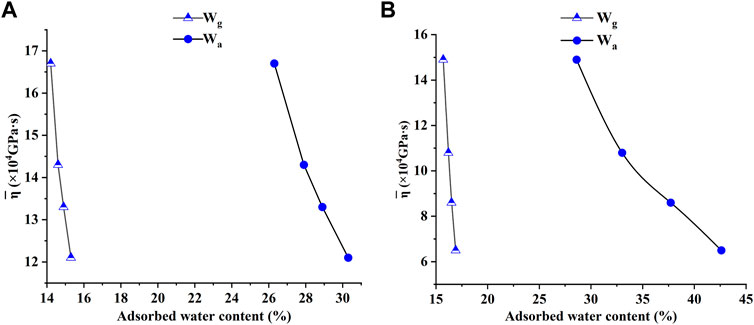
FIGURE 7. Curve of the average viscosity coefficient of samples with the adsorbed water content. (A) Kaolin; (B) bentonite.
The thickness of adsorbed water can explain the creep mechanism of soft soil to a certain extent. However, the adsorption energy of particles for water is mainly determined by the surface charges of particles. For clay particles, they have more surface charge and a larger specific surface area, and it is easier for clay particles to form a sizable volume of the adsorbed water layer or the double electric layer when interacting with water. For non-clay particles, the charge on the surface of these types of particles is smaller. At the same time, non-clay particles tend to have a larger particle size and smaller specific surface area, so their ability to adsorb water is weak, and the thickness of adsorbed water or the DEL is relatively thin. The electric field force on the particle surface is a direct factor in attracting ions and polar water molecules, while the gravity of the particles characterizes the scale effect of the particle. So, the energy scale method in this paper uses these two forces, which can quantitatively measure and explain the role of the particle mineral composition in the soft soil creep. Through the energy scale method, λ of each sample was calculated by Equation (1), and the relationship between the obtained λ and the average coefficient of viscosity is plotted in Figure 8.

FIGURE 8. Relationship curves between λ and the average viscosity coefficient. (A) Kaolin; (B) bentonite.
In Figure 8, it can be found that λ values of bentonite and kaolin group specimens all show a certain negative correlation with the clay mineral content. At the same time, λ values of the bentonite group specimens are all larger than those of the corresponding kaolin group specimens. With the increase of the clay mineral content, λ of the two groups of specimens also increased, and the increase of bentonite group specimens was larger than that of kaolin group specimens. It is not difficult to find that these phenomena are basically the same as those in Figure 6, which shows that the ratio of the microcoulomb force to the gravity of the particles obtained by the energy scale method can explain the mechanism of the soft soil creep at the microscopic level. At the same time, the ratio of the microcoulomb force to the gravity energy scale method can also quantitatively describe the influence law of the basic characteristics of the particles on the properties of the soft soil creep.
4 Conclusion
In this paper, the influence of the mineral composition, the mineral content, and adsorbed water on the soft soil creep properties was analyzed at the microscope level and the energy scale method was adopted. Then, the energy scale method was used to analyze and discuss the results of the direct shear creep test. Finally, the following three conclusions were drawn:
(1) The average viscosity coefficient of kaolin was bigger than bentonite even though they shared the same content, and they both decreased with the increase of the kaolin and bentonite contents. Compared with the kaolin group specimens, the bentonite group specimens decreased faster with the increase of the clay mineral content.
(2) The thickness of adsorbed water or the DEL on the particle surface is positively correlated with the soft soil creep. The creep deformation of soft soil is mainly the contact deformation between particles of adsorbed water or the DEL. When the content of adsorbed water or the DEL increases, the coefficient of viscosity decreases and the creep phenomenon is more evident. Also, the creep phenomenon of bentonite is more evident than that of kaolin because adsorbed water of bentonite is more evident.
(3) The ratio of the microcoulomb force to gravity is positively correlated with the adsorbed water content on the particle surface and negatively correlated with the average viscosity coefficient of soft soil. The ratio of the microcoulomb force to gravity characterizes the adsorption capacity of particles to polar water and ions at the micro level, so the energy scale method can explain the mechanism of the soft soil creep at the microscopic level and also quantitatively describe the influence law of the basic characteristics of the particles on the properties of the soft soil creep.
Data availability statement
The original contributions presented in the study are included in the article/Supplementary Materials; further inquiries can be directed to the corresponding author.
Author contributions
JY: conceptualization, methodology, investigation, data curation, visualization, and funding acquisition; TW: writing—original draft and supervision; JC: writing—review and editing; JH: resources.
Conflict of interest
The authors declare that the research was conducted in the absence of any commercial or financial relationships that could be construed as a potential conflict of interest.
Publisher’s note
All claims expressed in this article are solely those of the authors and do not necessarily represent those of their affiliated organizations, or those of the publisher, the editors, and the reviewers. Any product that may be evaluated in this article, or claim that may be made by its manufacturer, is not guaranteed or endorsed by the publisher.
References
Bai, B., Jiang, S., Liu, L., Li, X., and Wu, H. (2021a). The transport of silica powders and lead ions under unsteady flow and variable injection concentrations. Powder Technology 387, 22–30. doi:10.1016/j.powtec.2021.04.014
Bai, B., Zhou, R., Cai, G., Hu, W., and Yang, G. (2021b). Coupled thermo-hydro-mechanical mechanism in view of the soil particle rearrangement of granular thermodynamics. Computers and Geotechnics 137, 104272. doi:10.1016/j.compgeo.2021.104272
Brezzi, L., Cola, P. E. S., and Gabrieli, F. (2018). Collapse of granular–cohesive soil mixtures on a horizontal plane. Acta Geotechnica 15, 695–714. doi:10.1007/s11440-018-0725-7
Fang, Y. (2014). Theoretical and experimental investigation on size effect characteristic of strength and deformation of soil. Rock and Soil Mechanics 35, 41–47.
Gao, Y., Chen, Q., Yuan, Q., and Wang, Y.-H. (2023). The kinematics and micro mechanism of creep in sand based on DEM simulations. Computers and Geotechnics 153, 105082. doi:10.1016/j.compgeo.2022.105082
Gu, R., and Fang, Y. (2009a). Experiment Study of the Effects of Organic Matter on the rheological Characteristics of Soft Soils. China Civil Engineering Journal 6.
Gu, R., and Fang, Y. (2009b). Exploration of substance bases and mechanism of soft soil rheology. Rock and Soil Mechanics 6.
Huang, W., Wen, K., Deng, X., Li, J., Jiang, Z., Li, Y., et al. (2020). Constitutive Model of lateral unloading Creep of Soft Soil under Excess pore water pressure. Mathematical Problems in Engineering 2020, 1–13. doi:10.1155/2020/5017546
Huang, X. (2018). Division of energy scale and analysis of engineering properties for soil granular group. Guangzhou, China: South China University of Technology.
Kuhn, M. R., and Mitchell, J. K. (1993). New perspectives on soil creep. Journal of Geotechnical Engineering 119, 507–524. doi:10.1061/(asce)0733-9410(1993)119:3(507)
Liu, Z., Shao, J., Xie, S., Conil, N., and Zha, W. (2018). Effects of relative humidity and mineral compositions on creep deformation and failure of a claystone under compression. International Journal of Rock Mechanics and Mining Sciences 103, 68–76. doi:10.1016/j.ijrmms.2018.01.015
Naeini, S. A., and Mohammadi, S. “An investigation on the Effect of deep Mixing columns and geogrid on embankment Settlement on the Soft Soil,” in Proceedings of the International Conference on Geotechnical Engineering Investigation Methods and Applications, Miami. United States, March 2022.
Ni, H., and Huang, Y. (2020). Rheological study on influence of mineral composition on viscoelastic properties of clay. Applied Clay Science 187, 105493. doi:10.1016/j.clay.2020.105493
Tang, S. H. (2021). Analysis of bound water and its influence factors in Mixed clayey Soils. Water 13.
Tsugawa, J. K., Romano, R., Pileggi, R. G., and Boscov, M. (2019). Review: Rheology concepts applied to geotechnical engineering. Applied Rheol. 29, 202–221. doi:10.1515/arh-2019-0018
Wei, H., Liu, D. Y., Zhao, B. Y., Feng, Y. B., and Xia, Y. C. (2014). Study on the rheological properties and constitutive Model of shenzhen mucky Soft Soil. Journal of Engineering Science and Technol. Review 7, 55–61. doi:10.25103/jestr.073.09
Wu, Q. (2015). Research on influence of bond water on secondary consolidation and long term strength of soft clay. Changchun, China: Jilin University.
Xiang, G., Yin, D., Cao, C., and Gao, Y. (2021). Creep modelling of soft soil based on the fractional flow rule: Simulation and parameter study. Applied Mathematics and Computation 403, 126190. doi:10.1016/j.amc.2021.126190
Xiao, S., Fang, H., and Wang, Q. (2014). The bound water, consolidation and creep behavior of soft soil. Journal of Engineering Geol 22, 531–535.
Yang, Q. (2017). A Study on influence of bound water on viscosity Coefficient of Clays during Consolidation. Science Technol. and Engineering 17, 92–96.
Yuan, J., Lin, W., Liu, Z., Fu, Q., Ye, L., and Zhao, J. (2022). An improved Model to describe the Creep behavior of Soft Soil. Soil Mechanics and Foundation Engineering 59, 475–483. doi:10.1007/s11204-022-09839-y
Yuan, J., 2014. Test and analysis on influence of rheological phase material on soft soil rheological property Guangzhou. China: South China University of Technology.
Zhang, X., and Wang, C. (2011). Viscosity coefficient of structural soft clay. Rock and Soil Mechanics 32, 3276–3282.
Zhu, G., Zhu, L., and Yu, C. (2017). Rheological properties of soil: A review. IOP Conference Series: Earth and Environmental Science 64, 012011.
Keywords: creep, energy scale method, coefficient of viscosity, direct shear creep test, adsorbed water
Citation: Yuan J, Wang TJ, Chen J and Huang jA (2023) Microscopic mechanism study of the creep properties of soil based on the energy scale method. Front. Mater. 10:1137728. doi: 10.3389/fmats.2023.1137728
Received: 04 January 2023; Accepted: 28 February 2023;
Published: 14 March 2023.
Edited by:
Bing Bai, Beijing Jiaotong University, ChinaReviewed by:
Haiqing Zhang, Hebei University, ChinaChen Peipei, Beijing University of Civil Engineering and Architecture, China
Copyright © 2023 Yuan, Wang, Chen and Huang. This is an open-access article distributed under the terms of the Creative Commons Attribution License (CC BY). The use, distribution or reproduction in other forums is permitted, provided the original author(s) and the copyright owner(s) are credited and that the original publication in this journal is cited, in accordance with accepted academic practice. No use, distribution or reproduction is permitted which does not comply with these terms.
*Correspondence: Jian Chen, NjcyNDQ1Mzg5QHFxLmNvbQ==
 Jie Yuan
Jie Yuan Jian Chen
Jian Chen